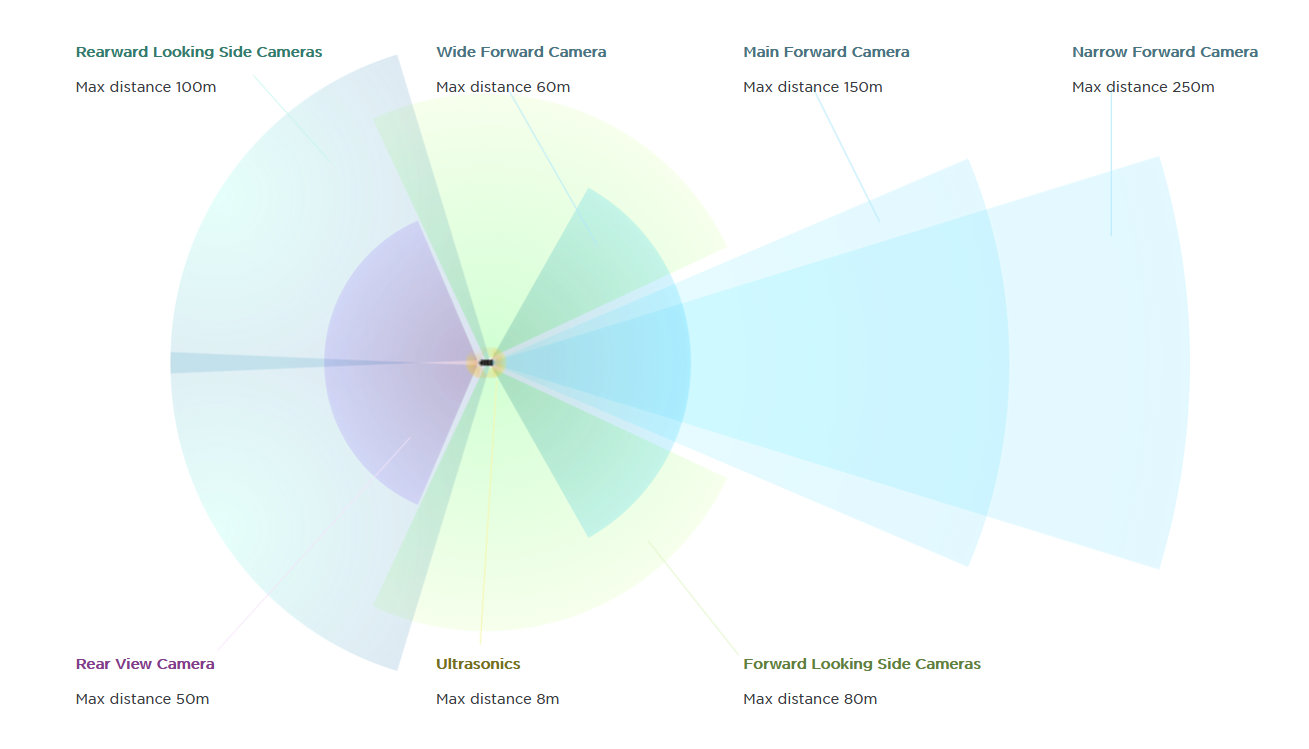As automotive companies look to stay competitive in an evolving market, integrating artificial intelligence (AI) has become a strategic priority across the industry. AI offers powerful benefits that enhance the efficiency, safety, and personalization of a range of automotive activities, from vehicle manufacturing to ride-sharing and insurance claims processing.
In this article, we overview the key benefits and use cases of AI, challenges for AI-driven automotive projects, as well as key tools your team can use for custom AI development. This article will be useful for companies who want to understand the role of AI in automotive industry work or are considering enhancing their operations with AI.
Contents:
- The impact of AI on the automotive industry
- Benefits of AI in the automotive industry
- Use cases for AI in the automotive industry
- What to consider when building an automotive AI solution
- Useful tools for automotive AI development
- The future of AI in the automotive industry
- How Apriorit can help you with AI development
- Conclusion
The impact of AI on the automotive industry
Companies on different sides of the automotive industry, from car manufacturers to shared mobility services, adopt AI solutions in an attempt to be more efficient, competitive, and safe. But do they get the desired effect?
By powering technologies like autonomous driving and driver assistance, AI reduces human error and helps prevent accidents. It also improves vehicle maintenance through predictive algorithms that detect issues early, reducing repair costs and downtime. On the production side, AI-driven automation streamlines manufacturing and enhances quality control, making production more consistent and cost-effective.
However, with benefits come pitfalls. Determining accountability in accidents with AI-driven cars raises legal and ethical questions. Data privacy is also a major concern, as AI-enabled vehicles and applications work with vast amounts of sensitive data that could be vulnerable to hacking. Additionally, the shift to AI-driven processes is altering the workforce, potentially displacing traditional automotive jobs and requiring new skill sets.
Let’s look closer into the pros and cons of adopting AI for automotive companies, starting with analyzing potential benefits.
Benefits of AI in the automotive industry
Artificial intelligence tools are swiftly transforming many automotive niches, from vehicle design and testing to fleet management and car sharing. It’s hard to overestimate the impact of AI in the automotive industry. The size of the global automotive AI market was valued at US$2.3 billion in 2022 according to research by MarketsAnd Markets. By 2027, it’s anticipated to be worth US$7 billion, growing at a CAGR of 24.1% during the forecast period.
AI helps automotive companies optimize their processes and be more competitive. Depending on their role in the industry, they can experience the following benefits:
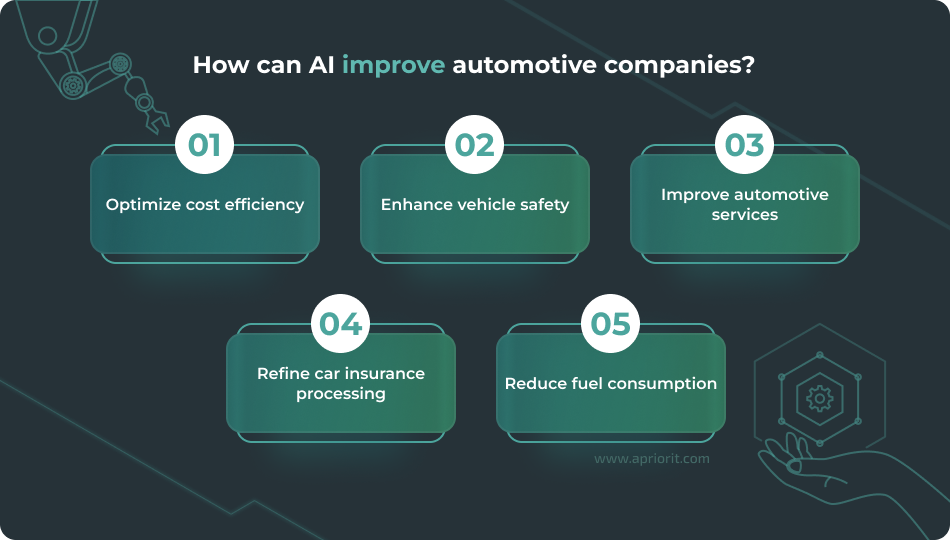
Optimize cost efficiency. AI can automate many long and resource-demanding processes, helping companies to improve supply chain logistics, manage inventory in real time, and predict parts demand. For example, AI-driven demand forecasting models can enable car manufacturers to avoid overproduction.
Enhance vehicle safety. Smart cars use multiple sensors to gather data on the conditions around them for advanced driver assistance systems (ADAS). When enhanced with AI, such systems can more effectively recognize objects on the road, detect lane departures, alert drivers to potential hazards, monitor driver fatigue, and make autonomous decisions in real time.
Improve automotive services. AI enhances the appeal and reliability of shared automotive services, shaping a more accessible and convenient urban mobility landscape. For example, it can optimize routes based on traffic patterns, predict vehicle demand across locations, and optimize pricing for shared mobility services. Implementing AI in this way, companies can increase user satisfaction and maximize their revenue.
Refine insurance processing. A huge part of insurance is processing claims and financial data and AI can significantly optimize this. AI algorithms can quickly analyze accident images, evaluate damage, and calculate repair costs, allowing for near-instantaneous claims settlement. An AI algorithm also can be part of a fraud detection solution, analyzing data from multiple sources to ensure fair claims processing.
Reduce fuel consumption. Whether a vehicle runs on electricity or gas, AI can make sure it goes farther with eco-driving features. Algorithms can adjust a vehicle’s speed and gear shifts for optimal fuel use, as seen in hybrid and electric vehicles. They can also optimize driving patterns for autonomous cars, suggest changes in driving style to the driver, and improve engine efficiency.
As you can see, AI can have many use cases for automotive companies. Let’s take a closer look at the key AI use cases in the automotive industry.
Make AI your competitive advantage
Let us build you a smart, scalable solution that will stay ahead in an evolving market.
Use cases for AI in the automotive industry
AI can enhance any part of the automotive industry, from the supply chain to the driver experience to vehicle maintenance. Here’s how AI can be used in the automotive industry:
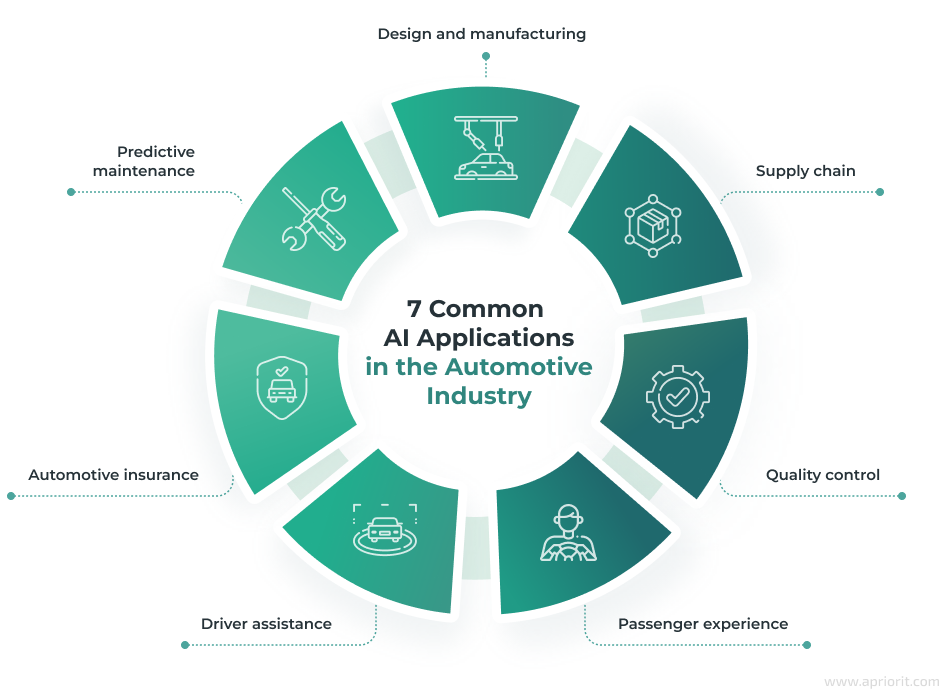
1. Design and manufacturing
AI-powered solutions and ML algorithms help vehicle manufacturers improve production processes, speed up data classification during risk assessments and vehicle damage evaluations, and do many other things. AI systems and robotics solutions relying on such technologies as computer vision, natural language processing, and conversational interfaces are widely applied in vehicle manufacturing.
For example, Toyota Research Institute uses generative AI models for car design, inspiring designers and turning their textual prompts into early concepts. BMW has upgraded several of its factories with additional cameras and sensors to incorporate AI into vehicle welding and quality inspection.
2. Supply chain
It’s vital for vehicle manufacturers to be able to monitor every stage of a component’s journey and know exactly when they can expect a component to arrive at its destination. That’s why modern supply chains often rely on cutting-edge IoT, blockchain, and AI technologies.
In particular, vehicle manufacturers can turn to solutions relying on different machine learning algorithms and AI-powered predictive analytics. With their help, manufacturers can estimate demand for components and predict possible changes in demand in a timely manner.
Ford is one company that is heavily investing in AI-based supply chain analytics to build a predictive supplier risk monitoring system and optimize production costs.
3. Quality control
AI can enable timely detection of various technical issues. Based on data gathered by in-vehicle sensors, an AI system can inform a user that a certain component or system requires maintenance or needs to be replaced as early as the need arises. Manufacturers also use AI-powered quality control systems to detect possible flaws in parts before they get installed.
In-car quality control systems mostly rely on data processing and analysis methods, while solutions used in manufacturing leverage image recognition and sound processing AI solutions.
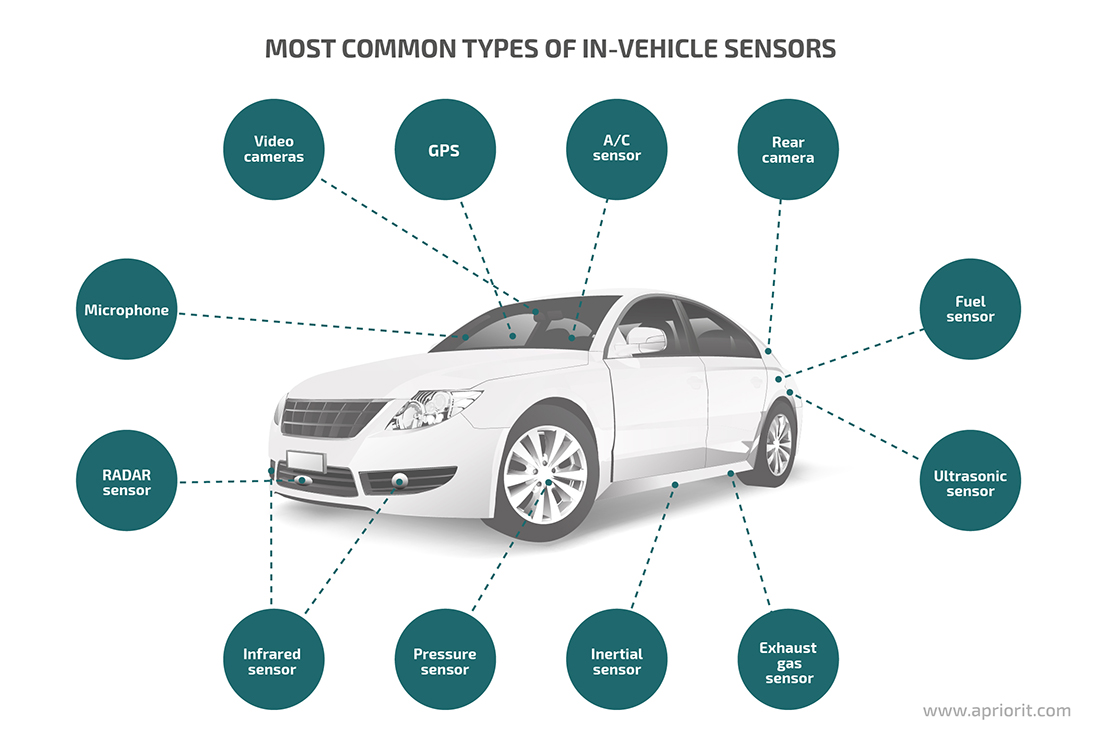
For example, BMW installed additional sensors and cameras on its conveyor belts to allow AI to perform visual and acoustic quality inspections. AI algorithms help employees ensure vehicle completeness and detect production anomalies in real time.
4. Passenger experience
To make sure all passengers are safe and satisfied, manufacturers enhance their vehicles with all kinds of AI-powered applications meant to upgrade the passenger experience.
Some systems use face recognition and emotion recognition methods to evaluate the state of the driver and passengers. Others deploy natural language processing and natural language generation methods to enable passengers to watch movies, listen to music, and even order goods and services while on the road.
For example, Dentsu and Hyundai invested $10 million in the Audioburst project to create an AI-powered infotainment system. Using automatic speech recognition and natural language understanding, this system will enable passengers to search music/audio libraries, enjoy personalized music playlists and news briefs, and so on.
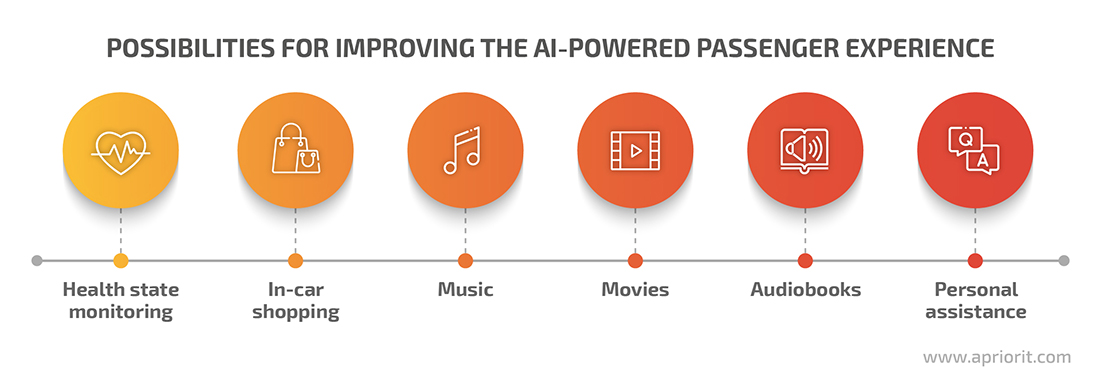
Mercedes-Benz is working on enhancing their in-car virtual assistant with generative AI to improve assistance personalization options, the quality of driver interactions, and entertainment for passengers.
5. Driver assistance
Of course, let’s not forget about improvements to the driving experience offered by AI technologies. There are AI systems meant to assist drivers and ensure safety by warning them about traffic and weather changes, offering the most efficient routes, or paying for goods and services on the go.
Audi’s virtual assistant calculates the optimal speed for the driver to catch green lights. This seemingly simple feature requires AI to process a lot of vehicle-to-infrastructure and vehicle-to-vehicle communications and make real-time adjustments based on the driver’s behavior.
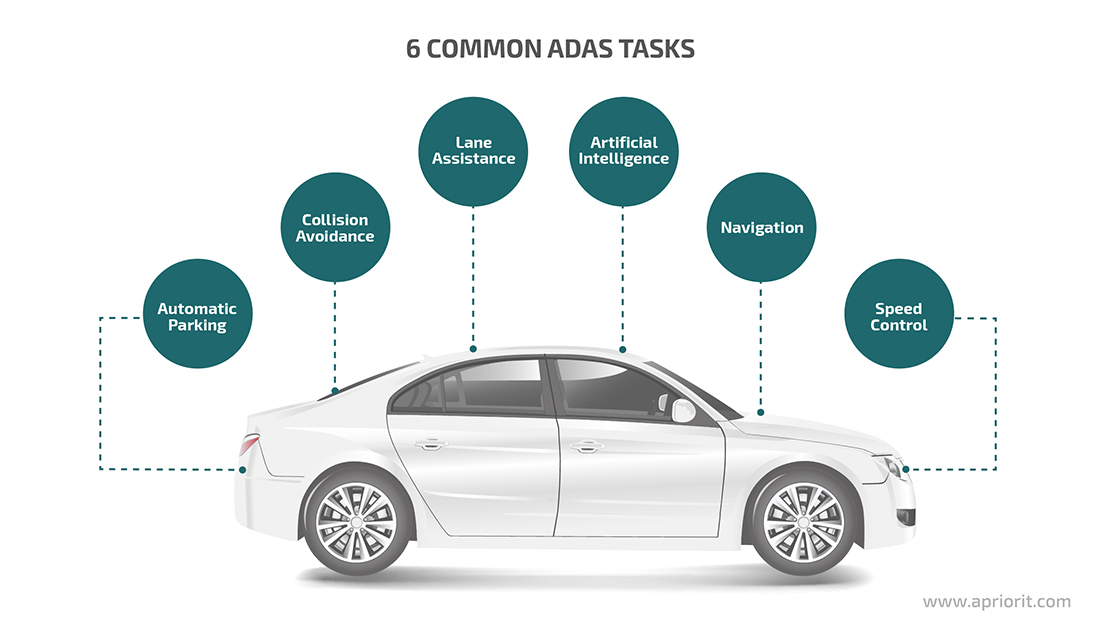
Other systems aim to take on the driver’s role — either temporarily, as with the autopilot functionality in some Tesla cars, or completely, as in Waymo’s driverless cars and Zoox’s autonomous vehicles for robotic ridesharing. These systems often combine complex computer vision capabilities with real-time analysis of big data and natural language processing.
6. Automotive insurance
AI-powered solutions have great potential in handling insurance claims. On the driver’s side, in-vehicle AI capabilities can be used for gathering incident data and filling out claims. Such a system would need to combine smart data analytics, speech recognition, natural language processing, and text processing and generation.
On the insurance provider’s side, AI systems leveraging image processing and object detection technologies can be of great help for improving the accuracy of vehicle damage analysis. One such system is Ravin Inspect, which documents and analyzes customer-provided information to help an insurance company make claims decisions.
7. Predictive maintenance
Traditional vehicle maintenance happens either on schedule or when something breaks, taking cars out of use for longer than necessary. Adopting AI-based predictive maintenance in the automotive industry helps businesses assess the amortization of a car’s components, schedule repairs when they are actually needed, and save money by procuring parts in advance.
For example, Volvo Trucks and Mack Trucks equip their vehicles with sensors and IoT devices for AI-powered remote diagnostics and preventive maintenance. Transportation companies that use Volvo and Mack trucks can take advantage of this to reduce the number of service disruptions and prepare for repairs in advance.
Read also
AI in Auto Insurance: Possibilities, Challenges, Implementation Tips
Examine how car insurance software works and how AI can enhance it, and get practical tips on building a custom AI solution for insurance.
What to consider when building an automotive AI solution
While AI has promising potential in the automotive industry, the practical adoption of this technology in vehicles has certain limitations. In this section, we overview the key pitfalls to expect when using artificial intelligence for automotive applications.
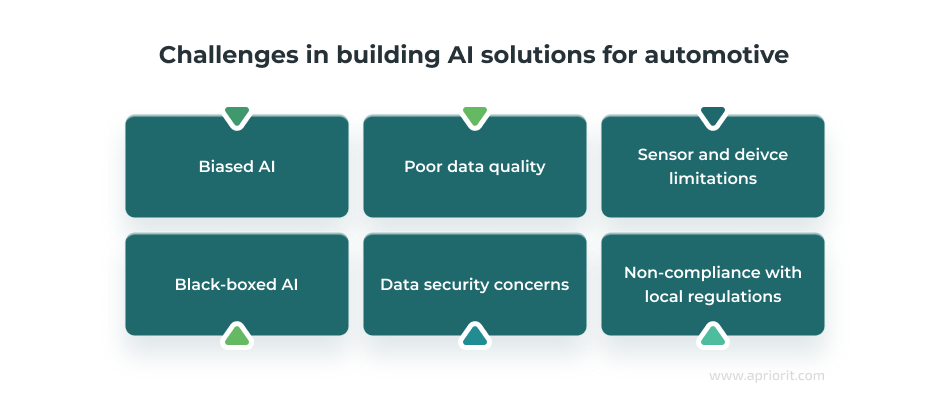
Biased AI
As AI systems tend to be biased, you can try to solve your task using robust algorithms instead of an AI system. Just make sure to analyze and thoroughly check all algorithms responsible for safety-critical functions. You can evaluate the correctness of algorithms either manually or with the help of special mathematical correctness proofs.
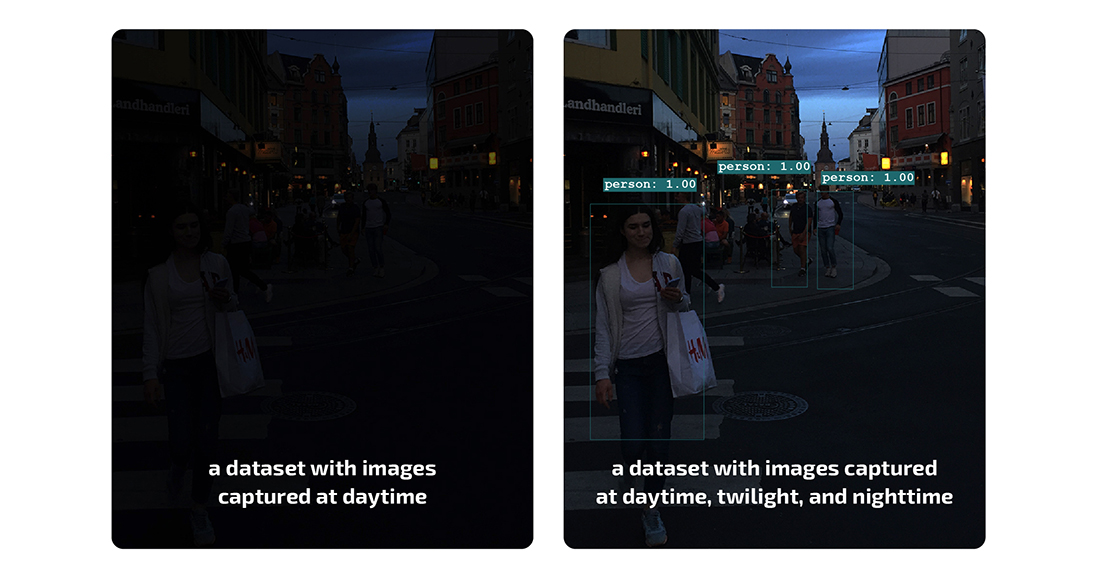
Figure 2. Recognition results for algorithms trained on different datasets
But note that retrained algorithm parameters can’t be applied right away. You should first check if the algorithm remains correct and functions properly after receiving new data, and only then apply it in production.
Poor data quality
Data is the core of any AI system, so it must be of the highest quality. However, collecting a large enough dataset filled with high-quality, properly labeled and annotated data is a true challenge. AI models used for smart vehicles must be predictable, precise, and fast enough to enable safe and accurate responses to different events on the road in real time.
Some of the needed data can be collected either from smart systems and robots used at the manufacturing plant or from in-car sensors. Other data needs to be created and improved artificially. And no matter the source, all data needs to be thoroughly checked and tested to ensure both its quality and its completeness.
Sensor and device limitations
The quality of data heavily depends on the technical capabilities of the sensors and devices used to collect it. That’s why gathering lots of meaningful data is useless if you receive it from the wrong sensors.
For example, when deploying a machine learning model to process audio data received from microphones, it might be more effective to record audio using ultrasonic devices instead of regular devices, as they can filter out background noise.
Black-boxed AI
Many of today’s AI solutions are black-boxed, meaning even a system’s developers can’t tell how it came to a particular decision. But for the automotive industry, it’s critical to rely only on explainable AI (XAI) solutions.
In contrast to black-box AI models, decisions made by XAI systems must be transparent and understandable for humans. This enables AI developers to detect possible defects in their algorithms and implement improvements in a timely manner.
Data security concerns
Automotive AI needs huge training datasets that cover multiple in-car operations, vehicle-to-vehicle communication, communication with the driver, passenger entertainment preferences, and more. And after AI software is released, it continues to gather sensitive data, which is necessary for it to work correctly.
Accumulating such vast data records on real vehicles and people raises many cybersecurity concerns. A company that develops and supports an AI-based automotive system has to protect collected data from cyber threats and human errors to ensure both the safety of drivers and passengers and regulatory compliance.
Non-compliance with local regulations
The applications of AI and deep learning in the automotive industry progress faster than the implementation of respective laws and regulations. There are some legal gaps regarding the development of AI-powered solutions for vehicle manufacturing and transportation. However, there are still some requirements you should take into account during software development.
You can take into account requirements and recommendations from:
- The Society of Automotive Engineers (SAE) International
- The US Department of Transportation
- The European Automobile Manufacturers’ Association [PDF]
- And other entities
Read also
Automotive Security Testing 101: Requirements, Best Practices, Tips on Overcoming Challenges
Security testing is one of the key steps in ensuring automotive software protection. Explore common cyberattack vectors for cars and useful practices to test susceptibility.
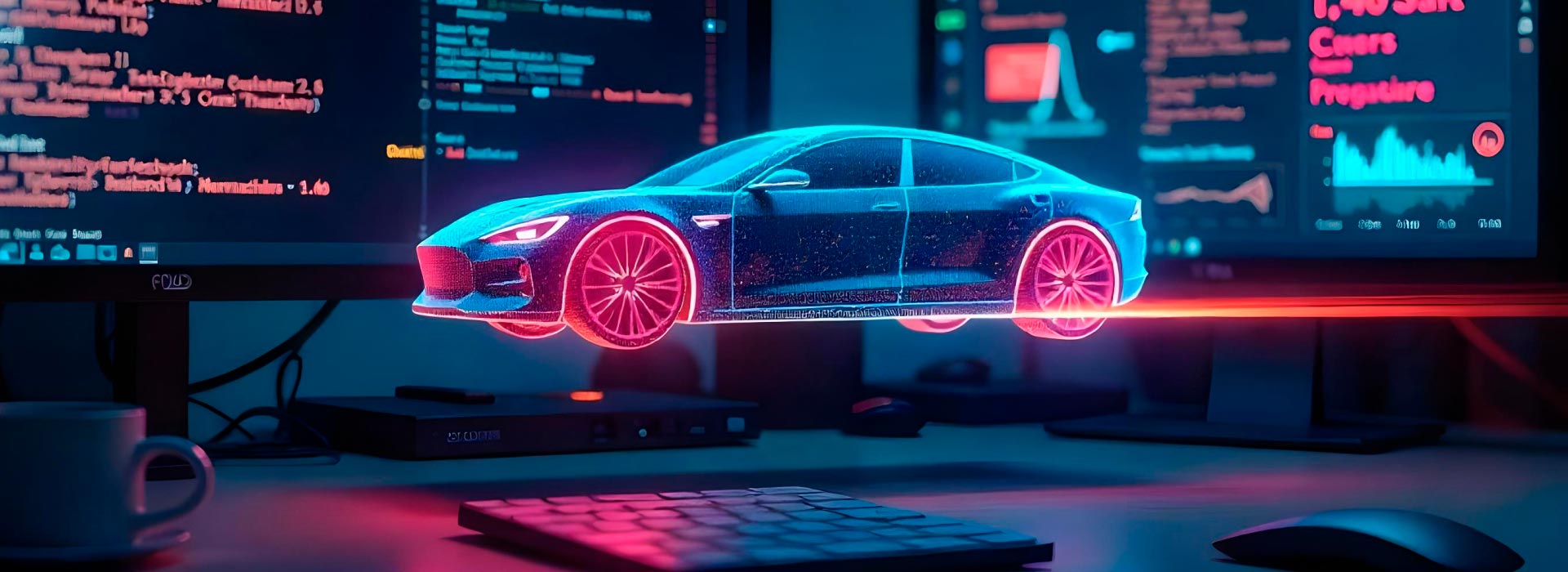
Useful tools and frameworks
Depending on the task at hand, you will need to use different datasets, libraries, and frameworks as well as pre-trained AI algorithms and models. Below, we list some common tools and frameworks that might be useful in your AI-powered automotive project.
Simulator platforms
Simulators are widely applied for designing concepts of future autonomous vehicles as well as for developing, training, and testing their systems. Let’s look at some of the most useful ones:
- CARLA is a popular open-source platform that can help you generate custom maps and simulate traffic scenarios or weather conditions for thorough training of your autonomous driving system.
- Cognata is a simulation platform for building ADAS and other AI-powered solutions for autonomous vehicles. It can be used for testing smart vehicle applications by simulating driving behavior in virtual 3D locations.
- Apollo Open Platform is an open autonomous driving platform that offers a perception system for analyzing data from different sensors, a simulator for modeling and testing autonomous vehicle performance, map creation capabilities, and more.
- Autoware is an open-source project providing ROS 2-based solutions for autonomous cars. Currently, the platform handles such tasks as object detection, localization, and mapping.
- NVIDIA DRIVE is a set of autonomous vehicle development platforms that includes capabilities for training deep neural networks and a simulation platform for testing and validating autonomous vehicle solutions. These platforms, however, are only accessible to those registered as NVIDIA developers and NVIDIA DRIVE Developer Program for DRIVE AGX participants.
- AirSim is an open-source simulator developed by Microsoft. It’s useful for research, training, and testing AI models for autonomous vehicles with realistic physics, environments, and capabilities for simulating diverse scenarios.
- LGSVL Simulator is an advanced open-source simulation platform tailored for developing and testing autonomous driving systems. Created by LG, it enables realistic 3D simulations to validate sensor setups and vehicle behaviors in various driving conditions.
- PreScan is a Siemens simulation tool designed for developing and testing ADAS and autonomous vehicle systems. It provides comprehensive tools for modeling sensor configurations, vehicle dynamics, and environmental factors, ensuring precise validation and optimization of AI-powered automotive technologies.
Computer vision libraries
Computer vision is an essential part of software for any autonomous driving system or ADAS system. It helps a vehicle to recognize objects, other vehicles, and pedestrians on the road, and change the driving style if needed, thus improving road safety. Here are the key tools we recommend for implementing computer vision algorithms:
- OpenCV is an open-source computer vision library widely used in automotive AI applications. It offers powerful tools for image processing, object detection, and motion analysis, enabling vehicles to interpret visual data from cameras in real-time.
- Detectron2 is a high-performance library developed by Meta for object detection and segmentation. Its modular design and support for state-of-the-art deep learning models make it ideal for identifying and understanding objects in the vehicle’s surroundings.
- You Only Look Once is a quick and accurate real-time object detection system. It is widely used in AI-based automotive systems to detect and track objects like pedestrians, vehicles, and road signs, ensuring quick decision-making in dynamic environments.
Open-source datasets
AI-based solutions show the best results when they are trained on properly prepared, high-quality datasets. There are several open-source datasets that you may find useful when working on an AI-based solution for the automotive industry:
- PandaSet is a free dataset created by Scale AI and Hesai. The dataset is licensed for both commercial and academic use and can be applied for various autonomous driving challenges. This dataset includes multiple 3D bounding boxes and point cloud segmentation data necessary for recreating realistic, complex urban environments.
- nuScenes is another useful open-access dataset that contains high-quality colored images and 400k lidar point clouds relevant to different daytime and weather conditions. The creators of nuScenes also released a Python devkit which makes it easier for AI developers to navigate this complex dataset.
- Waymo Open Dataset is a rich dataset with high-resolution sensor data collected by Waymo Driver-operated autonomous vehicles. It also contains labeled data for recognizing vehicles, pedestrians, cyclists, and road signs, and a motion dataset for determining object trajectory.
- Berkeley DeepDrive is one of the largest datasets for autonomous vehicles, which contains over 100,000 driving experience videos recorded on the roads of California and New York. This dataset can be used for training your models to solve tasks like detecting lanes and objects, tracking multiple objects, tracking segmentations, and more.
Data processing libraries and platforms
Whether you are planning to use AI for designing a new vehicle or enhancing it with driverless capabilities, your AI solution would have to process lots of data collected by different sensors: cameras, GPS, radars, lidars, and so on. Even the ready datasets created for training AI models for autonomous cars are complex and often require additional visualization tools. Below, we list some of the libraries and platforms that you might find helpful when working with data like lidar point clouds and 3D bounding boxes.
- deck.gl is a WebGL-powered library created at Uber and maintained by the vis.gl team. This library comes in handy when you need to perform visual exploratory data analysis of massive datasets.
- streetscape.gl (also known as AVS) is another library created by the vis.gl team. This library includes tools for visualizing autonomy and robotics data recorded in the XVIZ format. Similar to deck.gl, AVS allows for visualizing point clouds and bounding boxes, and it also supports real-time playback.
- Geospatial Data Abstraction Library (GDAL) is a powerful library that comes with a rich set of command line utilities for translating and processing geospatial data.
- NumPy is an efficient library that can be used for data analysis and array computing. Many other popular Python libraries, including Pandas and Matplotlib, are based on NumPy.
- Automated Driving Toolbox is a co-simulation framework that provides tools and algorithms for designing, simulating, and testing autonomous driving systems and ADAS. Using this framework, you can recreate different driving scenarios and simulate lidar perception, path planning, sensor fusion, and so on.
- Robot Operating System is a flexible framework for building robotics applications, including autonomous vehicles. It offers libraries and tools for tasks such as sensor data processing, motion planning, and system integration, making it a key resource for AI-driven automotive software development.
- Point Cloud Library is an open-source library designed for processing 3D point clouds. It provides tools for tasks such as object recognition, segmentation, and surface reconstruction, making it essential for AI systems that rely on lidar and other 3D sensors.
Read also
Navigating AI Image Processing: Use Cases and Tools
Explore the core stages of AI image processing, the top use cases, and the tools to develop a custom AI solution. We share insights into how businesses can leverage AI to automate image analysis, improve its accuracy, and overcome challenges in crafting AI-based image processing solutions.

The future of AI in the automotive industry
AI is already rooted in the automotive industry, helping companies improve the quality of their services, lower operating costs, and make the roads safer for everyone. As this technology improves, we’ll see more and more companies rely on AI algorithms.
Here are the areas of the automotive industry that are expected to change the most under the influence of AI:
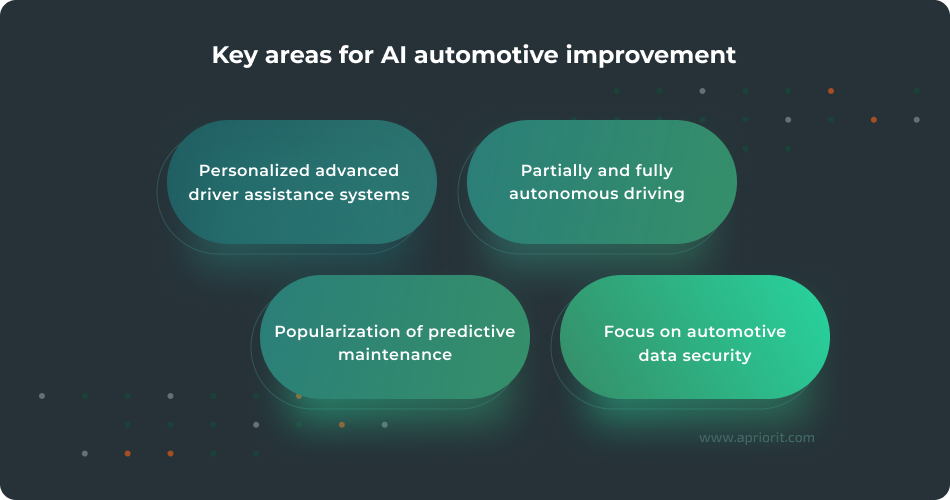
- Personalized advanced driver assistance systems. AI could soon anticipate a driver’s preferences across various conditions, such as weather and time of day, and offer context-specific support, like recommending alternative routes or automatically adjusting climate control settings. In the long run, ADAS might evolve into a co-driver role, continuously learning from the driver and improving safety and convenience with each trip.
- Partially and fully autonomous driving. Many vehicles already provide some features for partially autonomous driving, such as lane-keeping assistance and adaptive cruise control. While there are some fully autonomous vehicles, they raise a lot of security and efficiency questions. As AI algorithms become more sophisticated, fully autonomous vehicles could become safer, more efficient, and more widespread, ultimately transforming the way we approach driving and transportation.
- Popularization of predictive maintenance. In the coming years, predictive maintenance could become a standard feature in all connected vehicles — and the most common way to schedule car repairs. With widespread adoption, we might see AI systems that communicate with service centers in real time, ensuring that parts are ready and technicians are prepared before the vehicle even arrives.
- Focus on automotive data security. AI introduces additional cybersecurity challenges to automotive development and support, but it can also be used to enhance data protection. Future AI-driven security applications could instantly detect and counteract threats, monitor every system and network connection, and automatically apply security best practices to new data.
The automotive market changes quickly, so it’s best to start preparing for this future now. What better way to start than by finding a reliable partner?
How Apriorit can help you with AI development
As experts in AI development and a TISAX-certified company, we have all the skills and knowledge to deliver a custom AI-powered automotive solution. Whether you need firmware for embedded parts and IoT sensors or mobile applications for car-sharing, we can bring your solution to life.
Here’s how Apriorit can help you:
- Deep understanding of AI. In addition to practical work on AI development, Apriorit experts continuously research new models and algorithms to prepare for emerging challenges and stay ahead of the market.
- Full-cycle development services. Our experts can help you every step of the way, from researching the market and eliciting project requirements to providing post-release product support.
- Security of the development process and final solution. To guarantee software and data protection, we adhere to secure SDLC principles. We go beyond standard security practices and mechanisms to ensure software security at every product development stage.
- Focus on software quality. Quality assurance is an integral part of our development process. By starting QA early and paying attention to it throughout the development cycle, we ensure the release of high-quality software.
Our experience with AI development and the automotive industry will help us deliver a solution that fits your specific needs and wants.
Conclusion
The variety of possible applications of artificial intelligence in the automotive industry is impressive. Manufacturers can deploy AI technologies for designing and building new prototypes, improving the efficiency of their supply chains, and enabling predictive maintenance for both factory equipment and vehicles on the road.
AI is also the power behind driver and passenger assistance services delivering experiences such as driverless transportation, in-car shopping and entertainment, instant insurance claim filing, and so on.
But despite its promising potential, the use of AI in the automotive industry is associated with several challenges. Some of the biggest are associated with algorithm biases, data quality, and understanding how a model came to a certain conclusion.
At Apriorit, we have a team of passionate AI experts with experience in automotive development who are ready to assist with bringing your ideas to life.
Enhance your automotive software with AI
Let us build custom AI-packed software that will make your product more efficient and competitive.


